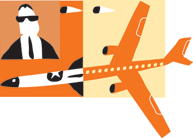P.O.V.: From inside the Pentagon, on 9/11
P.O.V.: From inside the Pentagon, on 9/11 McGill University
User Tools (skip):
P.O.V.
From inside the Pentagon, on 9/11
When the U.S. government released videotapes recently of American Airlines Flight 77 hitting the Pentagon on 9/11, it was intended to dispel conspiracy theories about the events of that day, but of course, we are already seeing letters to newspapers and weblogs that argue that the tapes are actually proof of the conspiracy.

TZIGANE
That morning, I saw the second plane hit the second tower of the World Trade Center from a unique vantage point: watching a television broadcast inside the Pentagon before it was hit. I was on a fellowship that put me into a desk officer's position on the Joint Staff from September 2001 to August 2002. 9/11 was the first day of my second week in the Pentagon. My experiences that day and my work as a social scientist cause me to be alarmed when people buy into bad ideas that seem to spread further than good ones, particularly when the evidence for the good is so staggering. How many of us saw the second plane — a commercial airliner, not a small plane, not a missile, and not a military plane — hit the WTC second tower? Most of us.
Certainly, the Bush Administration has given us great cause to doubt their statements, given the absence of weapons of mass destruction in Iraq. There is a significant difference between these two situations, however, as information about weapons programs is an inherently secretive process where details are sketchy and easy to manipulate.
But we have more than their word for 9/11. Not only do we have videotapes of the attacks on the Pentagon and the World Trade Center, we have scores of witnesses. One of my colleagues at the Pentagon that day was an Air Force Captain. He was waiting to be picked up by his wife at the moment the plane hit. She was late, stuck in traffic, and watched the plane fly right above her and into the building. Her first reaction was that she had killed her husband by being late.
The Pentagon is across the Potomac from downtown Washington. If you are like me, when you are on the phone, you look outside, and people in those office buildings have great views of the Pentagon and the city beyond. Plenty of folks were doing precisely that — talking on the phone and looking outside — when they saw an airliner, travelling very low and very fast, hit the Pentagon. I had several conversations during my year in Washington with such witnesses.
Conspiracy theorists would prefer to believe that the government, the military, and select members of society are engaged in a massive yet super-secret effort to fool the world. These agents of the conspiracy are clever, efficient and dedicated, if one believes the theories. The more realistic explanation for 9/11 is that government officials are actually rather petty, competitive and inept, that the CIA and the FBI cannot get along, and that the FBI itself was so bound up in its own procedures that it would not investigate warnings about individuals from the Middle East taking jet pilot courses.
Which is the better bet: super-competent government agencies or incompetent ones? As a political scientist and as an observer of reality, I would place my money on the latter.
Stephen M. Saideman is a Canada Research Chair in International Security and Ethnic Conflict at McGill.

